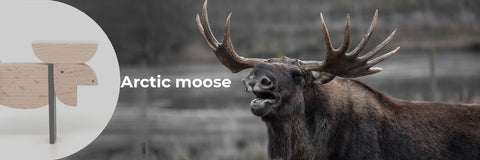We have a special collection dedicated to the Nordic animals, and if we think which the most suitable animal for January is, of course, the Nordic moose is the first that comes to mind. We wanted to combine minimalist design typical of the Northern countries and the animals that inhabit them in one series. The fox, the wolf, the moose and the owl have their Nordic versions, inhabiting the coldest territories of the world. With our Nordic Woods collection, our aim is to inspire you to show your children the world of Nordic animals; here are some facts about the moose you can tell your kids.
Moose are the biggest member of the deer family and among the world's tallest land mammals. They live predominantly in areas that have cold, snowy winters - like North America and Sweden. Their big hooves act like snowshoes helping them walk the snow or on muddy, marshy ground after the white stuff melts. A mature male moose is called a bull, the female is a cow. In Great Britain, a moose is called an “elk”. The word “moose” is derived from an Algonquin language and means “eater of twigs”

photocredits: Pixabay
Moose are the largest species of deer, the average adult standing between 4.6 and 6.9 ft (2,4 - 3,2 m) high. Their average weight is 771-881lbs (350-400kg). The Alaskan moose is the largest subspecies.
Moose cannot take heat much over 80F (27C). During a hot summer day, you’ll find them in the water trying to cool off. They are good swimmers and are able to keep speeds of about 6 miles an hour. When winter ice melts, moose spend much of their time swimming in lakes and rivers to keep their body temperature down on hot days, sometimes swimming without stopping for 10 or more miles. A moose can dive 20 feet under water and stay underwater for up to 30 seconds! On land, adult moose can run about 35 miles an hour (56 kilometres per hour). Even when they aren’t racing, they can trot at speed of about 20 mph and cover large distances.

photocredits: Jay Cathcart
Despite their size, moose are herbivorous and typically munch on shrubs, pinecones, moss and twigs. It takes a lot of twigs to keep an animal that size working, so the it spends most of its day eating as it requires a whopping 20-30 kg (40-70 lbs) of food per day! Because they are so tall, moose prefer to reach up and eat twigs, bark, and leaves from trees and shrubs. Like cows, moose are ruminants. A moose can store more than 50 kilos of food in its stomach. Moose will change their dining habits depending on the season. In summer, they typically stay in open areas where they eat plants that grow in fields and along streams and lakes. In winter, they gravitate toward forests to find cover from the elements and eat bark, pine cones, moss, and lichen.
The bull is recognizable by its huge antlers, which he sheds once a year in order to conserve energy for the winter. The antlers are one of the fastest growing organs of any animal and begin growing at a rate of one inch per day in spring. Much like pruning a rose bush, each year the antlers grow bigger until September when the velvet that covers the antlers dries and falls off. Moose often rub their antlers on trees which helps the velvet come off. Antlers aren’t used for anything in the summer, but come fall (when it’s mating season) they are used to intimidate rivals.
As well as antlers, the moose is immediately recognizable by its long face and a muzzle dangling below its chin. This flap of skin is known as a bell and sways beneath the moose’s throat.

Photocredits: Pexels collections
Unlike other deer species moose are solitary animals and don’t form herds. However, the bulls may come together around the mating season of September/October and battle with their antlers for desirable females. Most of the time, moose are loners.
Cows typically give birth to one or two calves in the spring. The calves stay with Mom for about a year until the next mating season. A baby moose’s (a calf’s) fur is reddish and it can outrun a human when it’s only 5 days old! Calves are born in the spring.
It can be also fun with the moose. They are also called rubber-nosed swamp donkeys. A moose can kick in any direction with its front hooves. They are not naturally aggressive, but moose will attack when they are threatened by people, dogs, or vehicles — or even when they are hungry or tired. You can tell a moose is going to attack when its ears are laid back, the long hairs on its hump are raised, and it starts licking its lips. You should back off and look for something like a car, building, or tree to hide behind.
Moose are not endangered, but they still face threats from humans and the climate crisis. In addition to hunting, moose face threats from habitat loss as humans move into their environment to build homes, farms, and infrastructure. They are often involved in car accidents and are hunted by wolves, black bears, and brown bears.

photocredits: Pixabay
Sources: wildfoottravel.com, treehugger, nothernontario.travel, thebiggreenk, arctic kingdom, kids national geographic


